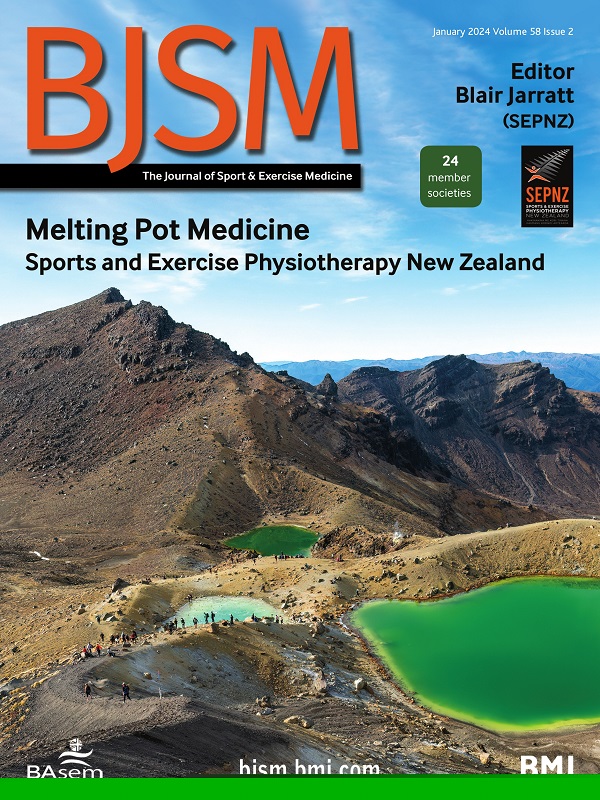Injury and illness epidemiology in elite athletes during the Olympic, Youth Olympic and Paralympic Games: a systematic review and meta-analysis
IF 16.2
1区 医学
Q1 SPORT SCIENCES
引用次数: 0
Abstract
Objective To systematically review and synthesise the incidence and characteristics of injuries and illnesses among athletes participating in the Olympic, Youth Olympic and Paralympic Games. Design Systematic review and meta-analysis. Data sources PubMed, Embase, CINAHL, Scopus and Web of Science were searched up to 2 July 2024, and Google Scholar, ClinicalTrials.gov and WHO International Clinical Trials Registry Platform up to 12 December 2023. Eligibility criteria for selecting studies Cohort studies conducted during the Games reporting injuries and illnesses among athletes. Risk of bias was assessed using the Joanna Briggs Institute critical appraisal tool for prevalence studies, and certainty of evidence using the Grading of Recommendations, Assessment, Development and Evaluation framework. Results 27 articles were included (10 Olympic, 4 Youth Olympic and 13 Paralympic Games). 23 articles had low, 3 moderate and 1 high risk of bias. Certainty of evidence was high to moderate for Olympic, high to low for Youth Olympic and low for Paralympic Games. Injury incidences per 1000 athlete-days were 6.5 (95% CI 5.9 to 7.2) during Olympic, 10.5 (95% CI 9.4 to 11.8) during Youth Olympic and 14.3 (95% CI 9.9 to 20.7) during Paralympic Games. Illness incidences per 1000 athlete-days were 3.6 (95% CI 2.8 to 4.7), 6.9 (95% CI 6.1 to 7.8) and 9.7 (95% CI 6.5 to 14.4), respectively. Lower limb injuries were frequent during Olympic and Youth Olympic Games, upper limb injuries during Paralympic Games and respiratory illnesses across all Games cohorts. Conclusions Injury and illness incidences were highest in Paralympic Games, followed by Youth Olympic and Olympic Games. Incidences and patterns of injury and illness were sport and context specific, which could inform future prevention strategies. PROSPERO registration number CRD42023475334. All data relevant to the study are included in the article or uploaded as supplementary information.奥运会、青奥会和残奥会期间优秀运动员损伤和疾病流行病学:系统回顾和荟萃分析
目的系统回顾和综合奥运会、青奥会和残奥会运动员伤病的发生率和特点。设计系统回顾和荟萃分析。检索的数据源为PubMed、Embase、CINAHL、Scopus和Web of Science,检索时间截止到2024年7月2日;检索b谷歌Scholar、ClinicalTrials.gov和WHO国际临床试验注册平台,检索时间截止到2023年12月12日。选择研究的资格标准在奥运会期间进行的报告运动员受伤和疾病的队列研究。使用乔安娜布里格斯研究所流行病学研究的关键评估工具评估偏倚风险,使用推荐、评估、发展和评估分级框架评估证据的确定性。结果共纳入27篇文献(奥运会10篇,青奥会4篇,残奥会13篇)。23篇文章为低偏倚风险,3篇为中等偏倚风险,1篇为高偏倚风险。奥运会的证据确定性从高到中等,青奥会的证据确定性从高到低,残奥会的证据确定性从低到高。奥运会期间每1000个运动员日受伤发生率为6.5例(95% CI 5.9 - 7.2),青奥会期间为10.5例(95% CI 9.4 - 11.8),残奥会期间为14.3例(95% CI 9.9 - 20.7)。每1000个运动员日的疾病发生率分别为3.6 (95% CI 2.8至4.7)、6.9 (95% CI 6.1至7.8)和9.7 (95% CI 6.5至14.4)。在奥运会和青奥会期间下肢损伤是常见的,在残奥会期间上肢损伤和呼吸系统疾病在所有奥运会队列中都是常见的。结论伤病率以残奥会最高,青奥会次之,奥运会次之。受伤和疾病的发生率和模式是运动和具体情况,这可以为未来的预防战略提供信息。普洛斯彼罗注册号CRD42023475334。所有与研究相关的数据都包含在文章中或作为补充信息上传。
本文章由计算机程序翻译,如有差异,请以英文原文为准。
求助全文
约1分钟内获得全文
求助全文
来源期刊
CiteScore
27.10
自引率
4.90%
发文量
217
审稿时长
3-8 weeks
期刊介绍:
The British Journal of Sports Medicine (BJSM) is a dynamic platform that presents groundbreaking research, thought-provoking reviews, and meaningful discussions on sport and exercise medicine. Our focus encompasses various clinically-relevant aspects such as physiotherapy, physical therapy, and rehabilitation. With an aim to foster innovation, education, and knowledge translation, we strive to bridge the gap between research and practical implementation in the field. Our multi-media approach, including web, print, video, and audio resources, along with our active presence on social media, connects a global community of healthcare professionals dedicated to treating active individuals.

 求助内容:
求助内容: 应助结果提醒方式:
应助结果提醒方式:


